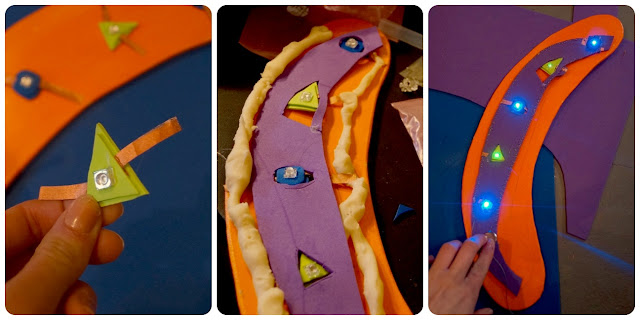1. An LED sandwiched between craft foam. The copper fabric acts as a
lead from the positive and negative legs of the LEDs. The color of the
foam corresponds to the color of the LED for my sanity because they're
all clear when they aren't on. The foam won't be seen in the finished
design.
2. Testing the circuit using conductive dough! I got the recipe from the Squishy Circuit demo (see previous post). I had to make sure the LEDs were lined up correctly so that I could use one battery to power them all in parallel.
3. After stitching conductive thread from one LED to the next along the sides of the purple foam, I tested the circuit with a 3v battery. Now to secure a place for the battery and add the switch!
 |
| We have a switch! |
I
decided to attach the battery to the back of the strip in the center
where it will be more secure. To ensure the battery doesn't slip, I used a
LilyPad coin cell holder which can be easily sewn into a soft circuit. The red craft felt (and a lot of hot glue)
acts as insulation between the conductive thread along the side and the
conductive thread running from the battery down to the bottom where I
put the switch. As much as I like the patchwork aesthetic, it's not going to hold up in the Space Garden. I want the real circuits to be secure and well
hidden from little hands. I will attach the whole circuit strip to the MDF panel, encase it with
fabric or yarn, and make the switch something easy to press or squeeze. The LEDs are meant to be less obvious until they are activated.




Comments
Post a Comment